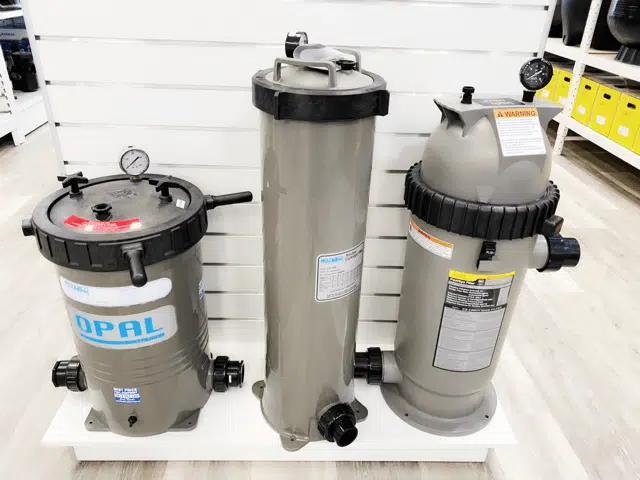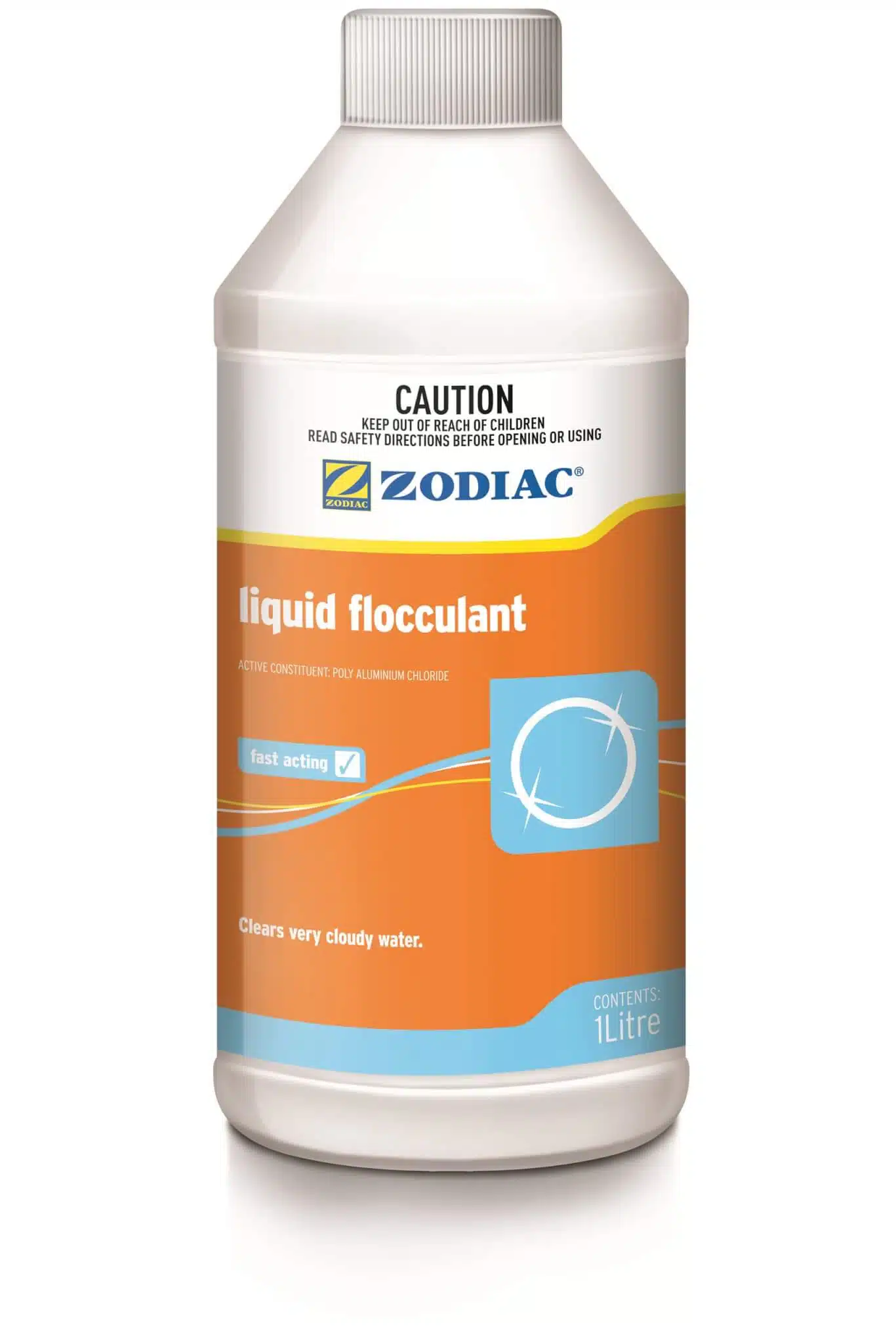- Fast Delivery Available!
- 211 Stirling Highway, Claremont, WA 6010
- 0412 561 620
- 0481 102 649
- Email Nicole
Cloudy pool water is a common problem for pool owners. There are 4 common pool issues that can cause cloudy water:
Here’s a step-by-step guide on how to fix these common issues, and how to clear up a cloudy pool fast using a clarifier or flocculant.


Filter problems are the main cause of cloudy pool water. If your filter isn’t functioning properly, then it can’t remove the tiny contaminants that cause cloudy pool water.
If you haven’t cleaned your filter in a while, it’s time to backwash your sand filter or clean the cartridge in your filter.
Your skimmer basket or pump basket is full of debris. Remove any leaves, twigs, or other debris in your skimmer or pump basket.
Your pool filter media needs replacing. If your filter media is worn out or damaged, it won’t be able to capture contaminants that cause cloudy water. To test if this is an issue. Backwash as usual, then once fully backwashed, run the pool on recirculate and see if the water coming out the jets is flowing faster or if your pool cleaner is moving faster on recirculate vs when on filter, if so then it is likely your media is restricting flow and not working as well as it should (recirculate puts the water through the MPV not the sand or media bed).
You’re not running your filter long enough. To fix a cloudy pool, all of your pool water must run through the filter system at least once a day. In summer you need to run your filter system for at least 8 to 12 hours a day typically.
Your pool pump or filter needs replacing. As it gets older, your pool filter system can start to fail and you may need to replace major pieces of equipment.
Cloudy water forms (as do pathogens and bacteria) when there’s not enough chlorine to sanitise your water. Chlorine levels can drop if there’s lots of debris like leaves in your pool.
Also, if there’s a build-up of bodily contaminants like sweat or sunscreen, or if your water is exposed to the sun’s UV rays and your chlorine is not properly stabilised.
Test your free chlorine and combined chlorine levels, add shock to rebalance your chlorine levels, and add stabiliser (not too much – just the right amount based on your accurate water test) to stabilise a sun-exposed pool.
Test your free chlorine levels. “Free Chlorine” is the amount of chlorine that’s available to sanitise your pool water. If these levels are low, you don’t have enough chlorine working in your water. To test for free chlorine you can take a sample to your local pool supply store. If you have a chlorine or salt water pool, your free chlorine and combined chlorine should read between 1 and 3 ppm (parts per million).
Calculate your combined chlorine levels. If your free chlorine levels are lower than your total chlorine levels, you can end up with chloramines. Chloramines are the byproduct of chlorine sanitising which can be irritating and even corrosive. Your Combined Chlorine is the difference between your Free Chlorine reading and the Total Chlorine reading. Your combined chlorine should be below 0.5 ppm.
To quickly bump up your free chlorine levels and remove chloramines, shock your pool using a sanitiser like Ezy Pool Sanitiser
Test and add cyanuric acid (stabiliser) if needed. Make sure you have the proper levels of cyanuric acid or CYA in your water. This will help prevent the sun’s UV rays from breaking down your chlorine too quickly. Your CYA levels should be between 30 and 50 ppm.
High levels of pH, Total Alkalinity, and Calcium Hardness can form scale. This can lead to bacteria growth, and cloudy water. Poor water chemistry makes it more difficult for your chlorine to function well and kill contaminants.
Test and balance your pH, total alkalinity, and calcium hardness levels.
Test and balance your Total Alkalinity (TA) levels.
Your alkalinity helps prevent fluctuations in your pH, so you’ll want to adjust these levels first. High alkalinity levels can cause pH and calcium scaling, which can cause cloudy water. To lower your alkalinity levels, use a pH decreaser. To raise your alkalinity levels, use an alkalinity increaser
Test and balance your pH levels. Improper pH levels can affect your chlorine and the other chemicals in your water. High levels of pH can cause calcium build-up and scaling which leads to cloudy pool water. Low levels of pH can cause your chlorine to become quickly depleted. This means it’s less effective at sanitising, leading to a build-up of contaminants and cloudy pool water. You can lower your pH levels with a pH decreaser. You can raise your pH with a pH increaser.
Test and balance your Calcium Hardness levels. High calcium hardness levels can cause calcium build-up and scale inside your pool plumbing and equipment. This creates a cloudy pool water problem that’s not easy to fix. If you have high calcium hardness levels, the only thing you can do is dilute your pool water. Partially drain your pool and refill with fresh water from a garden hose filter. It is important to remember that diluting your pool water will affect all of your water chemistry levels, so you’ll need to test your water again
Contaminants, particles, and small debris in your pool can cause cloudy water and early-stage algae growth may also cause cloudy pool water.
Treat algae in its early stages by cleaning and shocking your pool and adding a good quality algaecide.
Treat algae. If you already have visible algae growth, you’ll need to get rid of your algae problem before you treat your cloudy pool water. Unfortunately, algaecide won’t solve the problem totally (but you will need it to avoid it returning). To remove algae, you’ll need to skim, brush, and vacuum your pool. Be sure to bypass the filter by vacuuming on the waste setting. Then, you’ll want to shock your pool.
Test, balance, and clean your pool after heavy rains or storms. Storms can blow dirt and debris into your pool and the rain can dilute your pool water. That means your chlorine levels can drop, which we know can lead to cloudy water. Test and balance your water after a rainstorm and skim, brush, and vacuum the pool as needed.
If you need expert advice on what to do for a cloudy pool, come and visit one of our experts in store
If you want to fix cloudy pool water fast, you can use either a pool clarifier or pool flocculant. However, your cloudy pool water will return if you don’t correct the underlying causes. So be sure your filter system is running smoothly, your chlorine levels are correct, your water is balanced and you’ve eliminated any algae growth.
Clarifier helps bind tiny particles into bigger particles that your filter can capture. Be sure to read the manufacturer’s instructions to make sure you’re adding the correct amount for your size pool.
Clarifier works to clear mild cloudy pool water. Add it every other day as your filter runs until your water clears. If you have extremely cloudy water, you need to use a pool floc.
Follow the directions of your floc product and you should now see a big cloud at the bottom of the pool. This means the pool flocculant collected all the particles that were making the water cloudy and sank them to the bottom. And that means it’s time to vacuum.
If you just vacuum your water through your filtration system, it’ll just blow right back in through the return jets. Instead, you have to vacuum the water out of your pool to waste.
To do this with a multiport valve on your filter, just set it to the Waste option. This will send the pool water out of the backwash port as you vacuum. Keep a garden hose in your pool to refill your water while you vacuum.
For more specific advice, come in store anytime to see one of our experts

Fast and secure delivery throughout Perth and all over Western Australia.
POOL SHOP OUTLET HOURS
Shop Trading Hours 7 days a week, 9:00am – 5:00pm
Best Price Pool Equipment 2024 | All Rights Reserved | Privacy Policy | Sitemap
Website by 3BY2
"*" indicates required fields
"*" indicates required fields